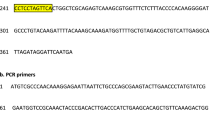Abstract
Contamination of cereals with mycotoxins produced byFusarium is a worldwide problem requiring rapid and sensitive detection methods. This paper describes the development of a PCR protocol facilitating the detection ofF. tricinctum, which belongs to the FHB (Fusarium Head Blight) complex responsible for contamination of cereal grains with enniatins and moniliformin. Sequence alignment of partial IGS rDNA revealed a single nucleotide polymorphism, which was used to design primers differentiatingF. tricinctum from other members of the FHB complex. The specificity of the assay was tested on 68 isolates belonging to 21Fusarium species originating from different parts of the world and hosts/substrates. Positive PCR results were obtained from all 12F. tricinctum isolates tested; however, unexpected amplicons were amplified from the templates ofF. acuminatum (CBS 618.87) andF. nurragi (CBS 393.96). No cross reactivity was found with any otherFusarium species tested.
The PCR assay was tested on 24 asymptomatic wheat seed samples originating from Northern Poland and resulted in 13 positive samples, of which 11 samples were contaminated with moniliformin and/or antibiotic Y.
Similar content being viewed by others
References
Bottalico A, Perrone G, 2002. ToxigenicFusarium species and mycotoxins associated with head blight in small-grain cereals in Europe. Eur J Plant Pathol 108: 611–624.
Chandler EA, Simpson DR, Thomsett MA, Nicholson P, 2003. Development of PCR assays to Tri7 and Tri13 trichothecene biosynthetic genes, and characterisation of chemotypes ofFusarium graminearum, Fusarium culmorum and Fusarium cerealis. Physiol Mol Plant Pathol 62: 355–367.
Demeke T, Clear RM, Patrick SK, Gaba D, 2005. Species-specific PCR-based assays for the detection ofFusarium species and a comparison with the whole seed agar plate method and trichothecene analysis. Int J Food Microbiol 103: 271–284.
Desjardins AE, 2006.Fusarium mycotoxins: chemistry, genetics, and biology. St. Paul, MN: Am Phytopathol Soc Press: 260.
Doohan FM, Parry DW, Nicholson P, 1999.Fusarium ear blight of wheat: the use of quantitative PCR and visual disease assessment in studies of disease control. Plant Pathol 48: 209–217.
Gonzáles-Jaén MT, Mirete S, Patino B, López-Errasquin, Vázquez C, 2004. Genetic markers for the analysis of variability and for production of specific diagnostic sequences in fumonisin-producing strains ofFusarium verticillioides. Eur J Plant Pathol 110: 525–532.
Hue F-X, Huerre M, Rouffault MA, Bievre C, 1999. Specific detection ofFusarium species in blood and tissues by PCR technique. J Clin Microbiol 37: 2434–2438.
Jurado M, Vázquez C, Patińo B, González-Jaén MT, 2005. PCR detection assays for the trichothecene-producing speciesFusarium graminearum, Fusarium culmorum, Fusarium poae, Fusarium equiseti andFusarium sporotrichioides. Syst Appl Microbiol 28: 562–568.
Kulik T, Fordoński G, Pszczółkowska A, Płodzień K, Łapiński M, 2004. Development of PCR assay based on ITS2 rDNA polymorphism for the detection and differentiation ofFusarium sporotrichioides. FEMS Microbiol Lett 239: 181–186.
Kulik T, Pszczółkowska A, Fordoński G, Olszewski J, 2007. PCR approach based on theesyn1 gene for the detection of potential enniatin-producingFusarium species. Int J Food Microbiol 116: 319–324.
Kristensen R, Torp M, Kosiak B, Holst-Jensen A, 2005. Phylogeny and toxigenic potential is correlated inFusarium species as revealed by partial translation elongation factor 1 alpha gene sequences. Mycol Res 109: 173–186.
Lee T, Oh DW, Kim HS, Lee J, Kim YH, Yun SH, Lee YW, 2001. Identification of deoxynivalenol-and nivalenol-producing chemotypes ofGibberella zeae by using PCR. Appl Environ Microb 67: 2966–2972.
Lee T, Han YK, Kim K-H, Yun S-H, Lee Y-W, 2002.Tri13 andTri7 determine deoxynivalenol- and nivalenol-producing chemotypes ofGibberella zeae. Appl Environ Microbiol 68: 2148–2154.
Leslie JF, Summerell BA, 2006. TheFusarium Laboratory Manual. Blackwell Publishing Professional 2121 State Avenue, Ames, Iowa, 50014, USA.
Llorens A, Hinojo MJ, Mateo R, Medina A, Valle-Algarra FM, Gonzalez-Jaen MT, Jimenez M, 2006. Variability and characterization of mycotoxin-producingFusarium spp. isolates by PCR-RFLP analysis of the IGS-rDNA region. Antonie van Leeuwenhoek 89: 465–478.
Mule G, Logrieco A, Stea G, Bottalico A, 1997. Clustering of trichothecene-producingFusarium strains determined from 28S ribosomal DNA sequences. Applied and Environmental Microbiology 63: 1843–1846.
Nicholson P, Simpson DR, Wilson AH, Chandler E, Thomsett M, 2004. Detection and differentiation of trichothecene and enniatin-producingFusarium species on small-grain cereals. Eur J Plant Pathol 110: 503–514.
Niessen ML, Vogel RF, 1998. Group specific PCR-detection of potential trichothecene-producingFusarium species in pure cultures and cereal samples. Syst Appl Microbiol 21: 628–631.
O’Donnell K, Kistler HC, Tacke BK, Casper HH, 2000. Gene genealogies reveal global phylogeographic structure and reproductive isolation among lineages ofFusarium graminearum, the fungus causing wheat scab, www.pnas.orgycgiydoiy10.1073ypnas.130193297.
Rosewich UL, Kistler HC, 2000. Role of horizontal gene transfer in the evolution of fungi. Annu Rev Phytopathol. 38: 325–63.
Schilling AG, Möller EM, Geiger HH, 1996. Polymerase Chain Reaction-Based Assays for Species-Specific Detection ofFusarium culmorum, F. graminearum, andF. avenaceum. Phytopathol 86: 515–523.
Tan MK, Niessen LM, 2003. Analysis of rDNA ITS sequences to determine genetic relationships among, and provide a basis for simplified diagnosis ofFusarium species causing crown rot and head blight of cereals. Mycol Res 107: 811–821.
Turner AS, Lees AK, Rezanoor HN, Nicholson P, 1998. Refinement of PCR-detection ofFusarium avenaceum and evidence from DNA marker studies for phylogenetic relatedness toFusarium tricinctum. Plant Pathol 47: 278–288.
Yli-Mattila T, Paavanen-Huhtala S, Parikka P, Konstantinova P, Gagkaeva TY, 2004. Molecular and morphological diversity ofFusarium species in Finland and northwestern Russia. Eur J Plant Pathol 110: 573–585.
Yoder WT, Christianson LM, 1997. Species-specific primers resolve members ofFusarium sectionFusarium. Taxonomic status of the edible “Quorn” fungus reevaluated. Fungal Genet Biol 23: 68–80.
Author information
Authors and Affiliations
Corresponding author
Rights and permissions
About this article
Cite this article
Kulik, T. Detection ofFusarium tricinctum from cereal grain using PCR assay. J Appl Genet 49, 305–311 (2008). https://doi.org/10.1007/BF03195628
Received:
Accepted:
Issue Date:
DOI: https://doi.org/10.1007/BF03195628




